Some Dogs Live in Silent Torture, Even Without Direct Abuse
No dog breed has ever been improved by these kinds of arbitrary decisions. And condemning a dog to a lifetime of suffering for this is not an improvement, whatever they say, it is torture. Here are 8 sad cases in point.

STORY AT-A-GLANCE
- Sadly, so-called breeding “improvements” have turned certain once-healthy breeds into deformed dogs
- A hundred years ago, dogs like the Bull Terrier, Boxer, English Bulldog, and Dachshund were well-proportioned, generally healthy, and physically active. Today’s versions of these breeds are markedly different
- Over the years, several breeds have been bred to exaggerate certain physical traits at the expense of their health, longevity, and quality of life
- Today’s German Shepherd Dog is no longer the athlete he once was with his sloped back and incoordination. And the 2015 Pug comes with an extensive list of brachycephalic-related disorders that make his health a constant concern
Editor's Note: This article is a reprint. It was originally published April 2, 2015.
Not long ago I ran across an article in a U.K. publication titled “How a Century of Breeding 'Improvement' Has Turned Once-Healthy Dogs into Deformed Animals.” It featured some rather stunning pictures of certain dog breeds as they looked 100 years ago, compared to how they look today.
The article led me to the blog it was borrowed from, Science and Dogs. The author of the blog post gives permission to use his before and after pictures, so I thought I’d share them with my readers here at Mercola Healthy Pets.
As a veterinarian, I’ve seen first-hand the problems created when dogs are bred exclusively to achieve a certain look, without concern for their health, mobility, or quality of life. It is deeply disturbing to me, with all we know about the suffering these animals endure, that breeders persist in exaggerating their dogs’ physical characteristics, even if it means sacrificing their health.
How Certain Dog Breeds Looked in 1915 vs. 2015
The images on the left are from a 1915 book titled Dogs of All Nations. The pictures on the right are today’s poorly bred version of the dog on the left.
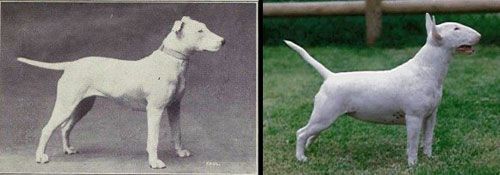
On the left is a well-conditioned, athletic Bull Terrier. The dog on the right has an altered skull and thick abdomen. Today’s Bull Terriers are prone to a long list of disorders, including extra teeth and compulsive tail-chasing.
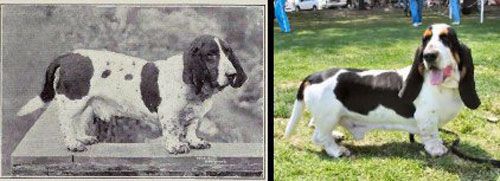
Look at how low to the ground today’s Basset Hound is. His shorter stature is the result of changes to the rear leg structure. He also has surplus skin, and needlessly long ears. Today’s Basset Hound’s droopy eyes are prone to eyelid abnormalities, and he also often suffers from problems related to his vertebra.
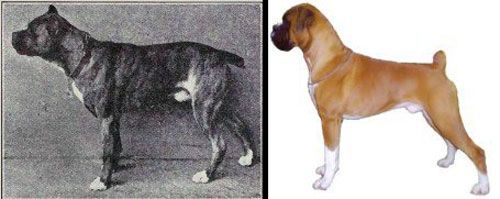
See how much shorter the Boxer’s face on the right is? Boxers are brachycephalic dogs, meaning they have pushed-in faces. Like many brachy breeds, the Boxer’s already short muzzle has been bred even shorter over the years, and slightly upturned as well. Brachys have difficulty breathing and controlling their body temperature, which often places extreme limitations on their physical abilities.
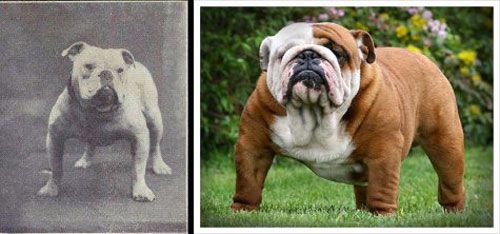
This unfortunate animal is the poster dog for all that is wrong with exaggerated breeding for looks. English Bulldogs suffer from an endless list of diseases, and according to one survey, their median age of death is 6.25 years. The massive size of today’s English Bulldog makes normal mating and birthing out of the question. They can’t reproduce without medical intervention.
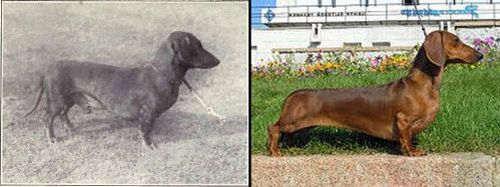
Dachshunds a century ago had short but functional legs and necks in proportion to their overall size. Since then, they have been bred for longer backs and necks, jutting chests, and legs so short their bellies barely clear the floor. Doxies have the highest risk of any breed for intervertebral disc disease, which can cause paralysis. They are also prone to dwarfism-related disorders, progressive retinal atrophy (PRA), and leg problems.
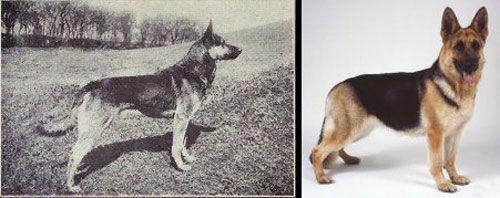
The German Shepherd Dog is another animal that has been ruined by unscrupulous breeding practices. In 1915, the GSD was a medium-sized dog averaging 55 pounds. Today’s GSD is a complete distortion of the original. He’s a good 30 pounds heavier, with a barrel chest, sloping back, and often a “drunken” gait. These dogs used to be magnificent athletic specimens, but no more.
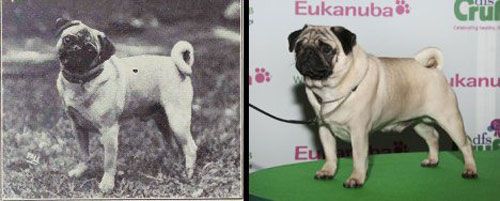
The Pug is another brachycephalic dog that has been bred to exaggerate the trait. The result? High blood pressure, heart problems, low blood oxygen levels, breathing problems, a tendency to overheat/develop heatstroke, dental issues, and skin fold dermatitis. At the other end of this poor dog is a “highly desirable” double-curl tail, which is actually a genetic defect that can result in paralysis.
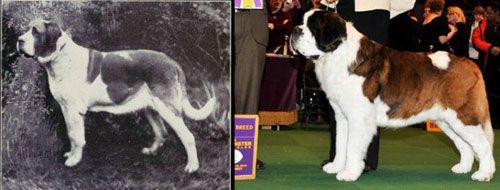
Today’s version of this once-highly skilled working dog is supersized, with a pushed-in face and excess skin. The Saint Bernard doesn’t do much work these days, because he quickly overheats. Some of the diseases he’s prone to include eye and eyelid abnormalities, Stockard’s paralysis (a spinal cord disorder), and bleeding disorders. I agree with the Science and Dogs blogger who concludes:
“No dog breed has ever been improved by the capricious and arbitrary decision that a shorter or longer or flatter or bigger or smaller or curlier ‘whatever’ is better. Condemning a dog to a lifetime of suffering for the sake of looks is not an improvement; it is torture.”











